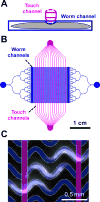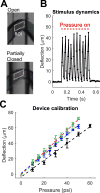Comparing Caenorhabditis elegans gentle and harsh touch response behavior using a multiplexed hydraulic microfluidic device
- PMID: 28914311
- PMCID: PMC5645015
- DOI: 10.1039/c7ib00120g
Comparing Caenorhabditis elegans gentle and harsh touch response behavior using a multiplexed hydraulic microfluidic device
Abstract
The roundworm Caenorhabditis elegans is an important model system for understanding the genetics and physiology of touch. Classical assays for C. elegans touch, which involve manually touching the animal with a probe and observing its response, are limited by their low throughput and qualitative nature. We developed a microfluidic device in which several dozen animals are subject to spatially localized mechanical stimuli with variable amplitude. The device contains 64 sinusoidal channels through which worms crawl, and hydraulic valves that deliver touch stimuli to the worms. We used this assay to characterize the behavioral responses to gentle touch stimuli and the less well studied harsh (nociceptive) touch stimuli. First, we measured the relative response thresholds of gentle and harsh touch. Next, we quantified differences in the receptive fields between wild type worms and a mutant with non-functioning posterior touch receptor neurons. We showed that under gentle touch the receptive field of the anterior touch receptor neurons extends into the posterior half of the body. Finally, we found that the behavioral response to gentle touch does not depend on the locomotion of the animal immediately prior to the stimulus, but does depend on the location of the previous touch. Responses to harsh touch, on the other hand, did not depend on either previous velocity or stimulus location. Differences in gentle and harsh touch response characteristics may reflect the different innervation of the respective mechanosensory cells. Our assay will facilitate studies of mechanosensation, sensory adaptation, and nociception.
Conflict of interest statement
We have no conflicts to declare.
Figures






Similar articles
-
The tactile receptive fields of freely moving Caenorhabditis elegans nematodes.Integr Biol (Camb). 2018 Aug 1;10(8):450-463. doi: 10.1039/c8ib00045j. Epub 2018 Jul 20. Integr Biol (Camb). 2018. PMID: 30027970 Free PMC article.
-
Touch-induced mechanical strain in somatosensory neurons is independent of extracellular matrix mutations in Caenorhabditis elegans.Mol Biol Cell. 2020 Jul 21;31(16):1735-1743. doi: 10.1091/mbc.E20-01-0049. Epub 2020 Jun 24. Mol Biol Cell. 2020. PMID: 32579427 Free PMC article.
-
In vivo imaging of C. elegans mechanosensory neurons demonstrates a specific role for the MEC-4 channel in the process of gentle touch sensation.Neuron. 2003 Sep 11;39(6):1005-17. doi: 10.1016/j.neuron.2003.08.015. Neuron. 2003. PMID: 12971899
-
Mechanosensation circuitry in Caenorhabditis elegans: A focus on gentle touch.Peptides. 2015 Jun;68:164-74. doi: 10.1016/j.peptides.2014.12.004. Epub 2014 Dec 25. Peptides. 2015. PMID: 25543196 Review.
-
Mechanosensory molecules and circuits in C. elegans.Pflugers Arch. 2015 Jan;467(1):39-48. doi: 10.1007/s00424-014-1574-3. Epub 2014 Jul 23. Pflugers Arch. 2015. PMID: 25053538 Free PMC article. Review.
Cited by
-
The tactile receptive fields of freely moving Caenorhabditis elegans nematodes.Integr Biol (Camb). 2018 Aug 1;10(8):450-463. doi: 10.1039/c8ib00045j. Epub 2018 Jul 20. Integr Biol (Camb). 2018. PMID: 30027970 Free PMC article.
-
Bioelectronics for Millimeter-Sized Model Organisms.iScience. 2020 Mar 27;23(3):100917. doi: 10.1016/j.isci.2020.100917. Epub 2020 Feb 14. iScience. 2020. PMID: 32114383 Free PMC article. Review.
-
Touch-induced mechanical strain in somatosensory neurons is independent of extracellular matrix mutations in Caenorhabditis elegans.Mol Biol Cell. 2020 Jul 21;31(16):1735-1743. doi: 10.1091/mbc.E20-01-0049. Epub 2020 Jun 24. Mol Biol Cell. 2020. PMID: 32579427 Free PMC article.
-
A high-throughput method to deliver targeted optogenetic stimulation to moving C. elegans populations.PLoS Biol. 2022 Jan 28;20(1):e3001524. doi: 10.1371/journal.pbio.3001524. eCollection 2022 Jan. PLoS Biol. 2022. Update in: PLoS Biol. 2023 Sep 21;21(9):e3002280. doi: 10.1371/journal.pbio.3002280. PMID: 35089912 Free PMC article. Updated.
-
Microfluidics for mechanobiology of model organisms.Methods Cell Biol. 2018;146:217-259. doi: 10.1016/bs.mcb.2018.05.010. Epub 2018 Jul 14. Methods Cell Biol. 2018. PMID: 30037463 Free PMC article.
References
-
- Chalfie M, Sulston J. Developmental Genetics of the Mechanosensory Neurons of Caenorhabditis elegans. Dev. Biol. 1981;82:358–370. - PubMed
-
- Way JC, Chalfie M. The mec-3 gene of Caenorhabditis elegans requires its own product for maintained expression and is expressed in three neuronal cell types. Genes Dev. 1989;3:1823–1833. - PubMed
Publication types
MeSH terms
Substances
Grants and funding
LinkOut - more resources
Full Text Sources
Other Literature Sources

